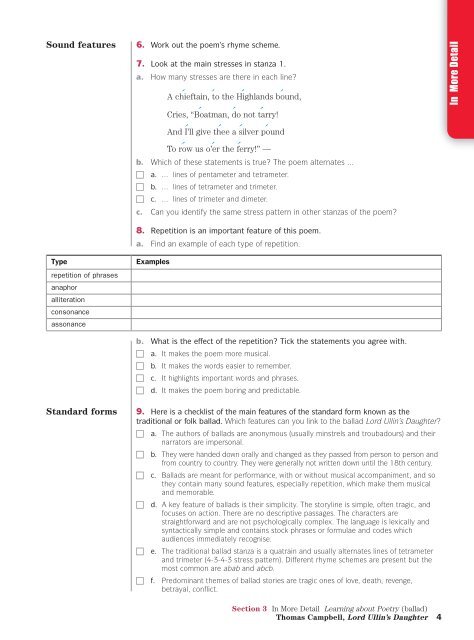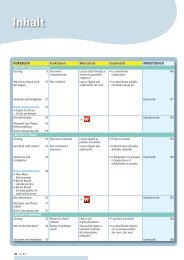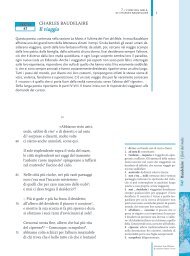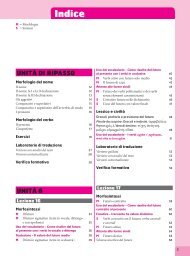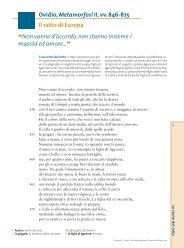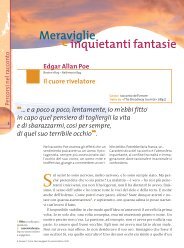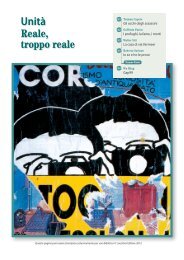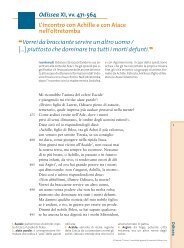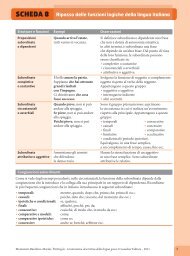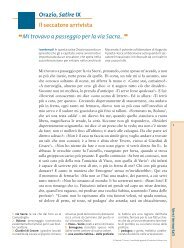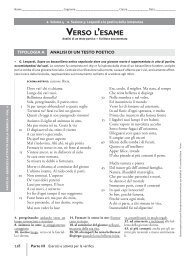Thomas Campbell, Lord Ullin's Daughter
Thomas Campbell, Lord Ullin's Daughter
Thomas Campbell, Lord Ullin's Daughter
You also want an ePaper? Increase the reach of your titles
YUMPU automatically turns print PDFs into web optimized ePapers that Google loves.
Sound features<br />
6. Work out the poem’s rhyme scheme.<br />
7. Look at the main stresses in stanza 1.<br />
a. How many stresses are there in each line<br />
´ ´ ´ ´<br />
A chieftain, to the Highlands bound,<br />
´ ´ ´<br />
Cries, “Boatman, do not tarry!<br />
´ ´ ´ ´<br />
And I’ll give thee a silver pound<br />
´ ´ ´<br />
To row us o’er the ferry!” —<br />
b. Which of these statements is true The poem alternates …<br />
a. … lines of pentameter and tetrameter.<br />
b. … lines of tetrameter and trimeter.<br />
c. … lines of trimeter and dimeter.<br />
c. Can you identify the same stress pattern in other stanzas of the poem<br />
In More Detail<br />
Type<br />
repetition of phrases<br />
anaphor<br />
alliteration<br />
consonance<br />
assonance<br />
Standard forms<br />
8. Repetition is an important feature of this poem.<br />
a. Find an example of each type of repetition.<br />
Examples<br />
b. What is the effect of the repetition Tick the statements you agree with.<br />
a. It makes the poem more musical.<br />
b. It makes the words easier to remember.<br />
c. It highlights important words and phrases.<br />
d. It makes the poem boring and predictable.<br />
9. Here is a checklist of the main features of the standard form known as the<br />
traditional or folk ballad. Which features can you link to the ballad <strong>Lord</strong> Ullin’s <strong>Daughter</strong><br />
a. The authors of ballads are anonymous (usually minstrels and troubadours) and their<br />
narrators are impersonal.<br />
b. They were handed down orally and changed as they passed from person to person and<br />
from country to country. They were generally not written down until the 18th century.<br />
c. Ballads are meant for performance, with or without musical accompaniment, and so<br />
they contain many sound features, especially repetition, which make them musical<br />
and memorable.<br />
d. A key feature of ballads is their simplicity. The storyline is simple, often tragic, and<br />
focuses on action. There are no descriptive passages. The characters are<br />
straightforward and are not psychologically complex. The language is lexically and<br />
syntactically simple and contains stock phrases or formulae and codes which<br />
audiences immediately recognise.<br />
e. The traditional ballad stanza is a quatrain and usually alternates lines of tetrameter<br />
and trimeter (4-3-4-3 stress pattern). Different rhyme schemes are present but the<br />
most common are abab and abcb.<br />
f. Predominant themes of ballad stories are tragic ones of love, death, revenge,<br />
betrayal, conflict.<br />
Section 3 In More Detail Learning about Poetry (ballad)<br />
<strong>Thomas</strong> <strong>Campbell</strong>, <strong>Lord</strong> Ullin’s <strong>Daughter</strong> 4


